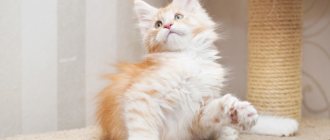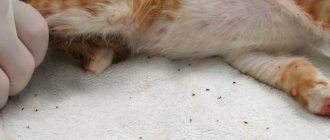If a cat has blood in the eye, this may be a sign of ailments such as dacryocystitis, traumatic injuries, neoplasms of the lacrimal glands, or hyphema. Any disease is accompanied by decreased vision and severe anxiety of the animal. At the first symptoms, your pet should be taken to a veterinarian, who will diagnose and prescribe treatment.
There are two types of bleeding - unilateral and bilateral. This is an important point to pay attention to when diagnosing the disease.
One-sided. In case of unilateral bleeding (from one nostril), the animal must be examined by a veterinarian. The most common causes of this are foreign bodies in the nose, trauma and tumors.
Two-way. Bilateral bleeding (from both nostrils) may indicate an infectious disease.
Normal or pathological?
Certain breeds of cats (especially Scottish, British and Persian) have a greater amount of fluid draining from their eyes. This is due to the anatomical features of the structure of the skull and the short nasolacrimal duct, the normal functioning of which is disrupted.
After sleep, any pet may also experience lacrimation. Small clots of mucus accumulate in the corners of the eyes of cats, which dry out, and the cat removes them when washing itself.
If a cat develops brown discharge from the eyes, the development of a pathological process should be assumed, especially if the disturbances persist for several days.
It is recommended to carefully monitor the pet, assess the dynamics of the disease, eliminate factors that provoke increased symptoms, and show the cat to a veterinarian. Diseases that manifest as brown discharge from the eyes can affect various parts and systems of the cat's body.
What breeds may have eye problems?
It is normal for British, Scottish and Persian cats to have watery eyes. This is mainly due to long hair that irritates their eyes or short tear ducts. In Persians, this is aggravated by the structural features of their bulging eyes.
Don't forget that cats, like people, can have watery eyes in the morning for no reason. These are the so-called “morning tears”. Another important factor is the young age of the kittens; they may not be able to wash themselves well enough. In this case, they need your help - just wipe their eyes with a damp cotton pad.
Secondly, keep track of how often and in what quantity the tears flow? If you accidentally notice them, this is the first time and your pet is not worried at all, then this may be an allergic or other one-time reaction. In this case, it will be enough to rinse your eyes and strengthen your care for a while.
Common causes of non-purulent eye discharge in cats
What can cause brown discharge from the eyes of domestic cats:
- presence of a foreign object in the eye: speck or hair;
- trauma, damage to the eyelids, eyes or head;
- allergic reactions;
- anatomical features and defects, for example, narrow nasolacrimal ducts, closed lacrimal ducts (dacryocystitis), abnormal growth of eyelashes inside the eyelid (trichiasis);
- benign and non-benign tumors that mechanically compress the tear ducts.
Dark discharge from the eyes of cats can be caused by a number of infectious diseases that affect the structures of the eye. Including dark discharge appears due to inflammation of the mucous membrane of the eyes (conjunctivitis), inflammation of the cornea and mucous membrane (keratoconjunctivitis), involvement in the inflammatory process of the eyelids (blepharitis), cornea (keratitis), inflammation of the lining of the eyeball (uveitis), vascular dysfunction eyes (iridocyclitis).
Another dangerous cause of dark discharge from the eyes can be glaucoma, which develops as a result of a chronic inflammatory process, dystrophic-degenerative diseases of the organs of vision, or after eye surgery.
By the nature of the discharge from the eyes, its color and consistency, one can presumably determine the underlying pathology that caused the discharge. With bacterial conjunctivitis and keratitis, the exudate is predominantly purulent, yellow, green or light brown.
If the infectious disease is of viral origin, then there is no purulent discharge, and the owner observes cloudy, thick mucus. When you have cat flu, the discharge is milky in color. In case of infectious diseases, you should pay attention to the general condition of the cat: as a rule, it becomes lethargic and loses its appetite.
A common cause of brown discharge from the eyes in cats is epiphora. This condition occurs due to the closure of the nasolacrimal passages and causes itching, dermatitis and hair loss in the periorbital area.
In case of allergic reactions, eye injuries and foreign body penetration, profuse lacrimation and redness of the eyes appear. In healthy animals, it is considered normal if a clear, odorless liquid is released from the eyes in a minimal volume, and such lacrimation disappears after a short time.
What can cause a cat's eye to bleed?
The development of pathology is due to the traumatic form of keratitis, that is, mechanical damage to the cornea of the eye. The manifestations of the disease, and, consequently, its therapy, directly depend on the type of damage (blunt or sharp object) and its extent.
Much less frequently, the disease develops as a result of thermal or chemical injury to the eye. A cat's visual organ can get boiling water or a chemical substance, but this happens quite rarely, because the eyes have natural protection in the form of eyelashes and eyelids.
In most cases, injuries are mechanical in nature; the animal can get rubble from the road surface, a sharp plant in the grass, or get injured in a fight with another representative of its species.
If the visual organ is damaged by a sharp object or a cat's claw, trauma can affect not only the eyelid and cornea, but also the choroid. In this case, bleeding from the visual organ may occur.
If the pet’s injury was caused by the claw of another cat, then it is necessary to inform the ophthalmologist about this, since a huge number of different microorganisms penetrate from the surface of the claw into the eye, and this is dangerous for the development of bacterial inflammation in the eye - endophthalmitis. This condition requires urgent antimicrobial therapy.
In mild form and at the earliest stage, traumatic keratitis may have the following symptoms:
- formation of a white film on the corneal layer;
- the pet’s constant desire to scratch the sore visual organ;
- increased lacrimation;
- strabismus;
- light bleeding.
In more serious cases, the following symptoms may be added to the symptoms described above:
- Partial loss of vision (the animal constantly bumps into pieces of furniture and walls).
- Change in behavior (the pet’s appetite decreases and it becomes more passive).
- A foreign object is visible in the visual organ.
- The iris of the eye changes its natural color.
- The cat does not allow anyone to see the diseased visual organ.
- The affected eye is covered most of the time by the eyelid.
- Tears are constantly released from the eye, mixed with mucus, pus and blood.
Having discovered that blood is flowing from a cat’s eye, you must first rinse the affected visual organ with cool boiled water and apply a gauze bandage to it. It is not recommended to take any further actions on your own.
The pet must be urgently taken to the veterinary clinic for an in-person appointment with an ophthalmologist. The doctor will conduct all the necessary examinations and prescribe effective therapy.
Signs of a serious illness
Experts identify quite a few diseases that provoke poor blood clotting. In case of illness, the animal may also experience other symptoms - for example, red spots on the ears and gums, pale gums. Also, the cat may not want to get out of bed in the morning and will lie all day due to loss of strength and lethargy.
Reduced blood clotting in cats can occur due to diseases such as viral leukemia and viral immunodeficiency. It can be caused by side effects of anti-inflammatory drugs. Another common reason is as a result of pathologies of the systems responsible for blood clotting, for example, disseminated intravascular coagulation syndrome, liver failure, hemophilia. Severe purulent discharge with blood from the eyes or nose may also indicate the presence of worms.
The main reasons for the development of Hyphema in cats
The extent of the problem is different for all cats. In some, only a red thread is visible in the eyes, in others, the organ is completely swollen with blood. The reasons for this negative phenomenon may be the following factors:
- Injury to an organ or skull. If a cat's eye is bloodshot, then it may be internal bleeding, which appears as a result of a strong blow, a fight with other animals, a fall from a height, or a collision with a bicycle or car. Hyphema is not essentially a disease in this case. This is a sign of a severe process in tissues and organs due to injury. In this situation, you should definitely take your pet for examination to a veterinary clinic and have an X-ray, ultrasound or magnetic resonance imaging examination done. Only on the basis of the data obtained can an accurate diagnosis be made and the cause of the appearance of a blood spot on the eye determined. Treatment is prescribed in the form of blood thinning drugs that calm the nervous system, as well as vitamin complexes. If it is determined that blood on the membrane appears against the background of bleeding inside the skull, then the doctor may prescribe surgical intervention;
- Uveitis. If a cat's eye is bloodshot, then the cause may be an inflammatory process localized in the choroid. As a result of inflammation, small capillaries burst, resulting in bruising on the cornea. Treatment is prescribed by a veterinarian after a visual examination and ultrasound examination;
- Neoplasms growing in the organs of vision. If a kitten's eye is bloodshot and there are no other symptoms that would indicate an injury, then the cause may be a growing tumor. The tumor can be not only in the visual organ, but also in the skull and brain. In this case, strong pressure forces the vessels to burst. At the same time, the eyes become bloodshot. The process is very dangerous and requires due attention. Blood tests are required for a biopsy, the doctor prescribes special treatment to prevent the development of metastases;
- General diseases such as diabetes, thrombocytopenia, previous infections. In this case, the owners usually know about the health problems of their ward, so the occurrence of hyphema does not come as a surprise.
How to help your pet
If your pet has discharge that may be a sign of eye disease, it is recommended to seek help from a veterinarian. The specialist will conduct a diagnosis, determine the pathology and prescribe treatment. If necessary, you can wash your cat's eyes yourself at home. For this purpose, an aqueous solution of furatsilin
,
saline solution
or
herbal decoctions: chamomile, calendula, loose leaf tea brews
.
To carry out this procedure on an adult cat, it must be carefully secured by wrapping it in a cloth or towel. It is more convenient to do this together with an assistant.
If the eyelashes are stuck together and crusts appear on the cat’s eyelids, you should blot them with a gauze swab soaked in a furatsilin solution, then carefully clean the eyes with movements from the inner corner to the outer. Additionally, you should clean your pet's nose, eyebrows and cheeks.
After washing, the eyes are instilled with medications as prescribed by the veterinarian. To avoid infection, it is necessary to regularly examine your pet, clean the eye area if dirt accumulates, limit contact with possible allergens and sick animals, monitor the diet, increase the cat’s nutrition with vitamin and mineral complexes, vaccinate the animal and carry out regular deworming.
Sources:
https://kinpet.ru/u-koshki-korichnevye-vydeleniya-iz-glaz-prichiny-i-lechenie/
https://infokotiki.ru/zabolevania/gl/u-kota-iz-glaza-techet-krov.html
https://aquatech-spb.ru/koshki-bolezni/krov-iz-nosa-u-kotenka.html











